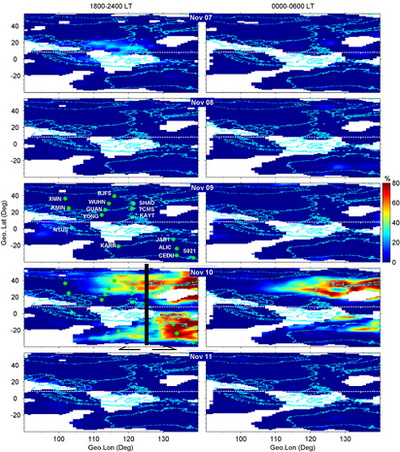Highlight 2009-024Update time:09 04, 2009
Journal of Geophysical Research Space Physics,2009,114, A07304, doi:10.1029/2009JA014057.
Characterizing the 10 November 2004 storm-time middle-latitude plasma bubble event in Southeast Asia using multi-instrument observations Guozhu Li,Baiqi Ning,Biqiang Zhao,Libo Liu,Weixing Wan,Feng Ding,J. S. Xu,J. Y. Liu,K. Yumoto Abstract
The development and dynamics of ionospheric plasma bubble (PB) irregularity during the super storm of 7–11 November 2004 are investigated using the data from a multi-instrument network operated in Southeast Asia. Analysis of fluctuations in Global Positioning System total electron content (GPS TEC), ionosonde, GPS scintillation, and in situ satellite density data indicates a series of intense PB-associated irregularities at equatorial, low, and middle latitudes in the Japanese longitude on 10 November. However, in the Chinese sector, the scintillations and PB irregularities are confined within the range of 20–50°N in geographic latitude and 110–125°E in geographic longitude. The absence of equatorial PB irregularities in this sector shows a major difference from that in the close-by longitude Japanese sector. In the Southern Hemisphere Australian sector, the irregularities occurrence is present as a symmetrical distribution at conjugate latitudes. Combined analysis of the data from Osan and Wuhan ionosondes illustrates that the middle-latitude spread F irregularities initially develop at the lower part of the F region and then distribute in the whole F region. This initiation of spread F at lower altitudes indicates that the middle-latitude PB-associated irregularities are locally generated. These results together with the irregularities occurrence sequence from higher to lower latitudes, and the onset time delay of several hours implies that the presence of PB-associated irregularities within a latitude range of 20–50°N in the Chinese sector cannot be attributed to the effects of prompt penetration electric fields (PPEFs), although the equatorial PBs in the close-by longitude are seen to be associated with PPEFs. The possible mechanism is the F region plasma instabilities triggered by wave structures, which act as an external driving force and seed active plasma dynamics and instability growth at middle latitude.
|
Contact
Related Articles
Reference
|
-
SIMSSecondary Ion Mass Spectrometer Laboratory
-
MC-ICPMSMultiple-collector ICPMS Laboratory
-
EM & TEMElectron Microprobe and Transmission Electron Microscope Laboratory
-
SISolid Isotope Laboratory
-
StIStable Isotope Laboratory
-
RMPARock-Mineral Preparation and Analysis
-
AAH40Ar/39Ar & (U-Th)/He Laboratory
-
EMLElectron Microscopy Laboratory
-
USCLUranium Series Chronology Laboratory
-
SASeismic Array Laboratory
-
SEELaboratory of Space Environment Exploration Laboratory
-
PGPaleomagnetism and Geochronology Laboratory
-
BioMNSFrance-China Bio-mineralization and Nano-structure Laboratory

 Print
Print Close
Close
